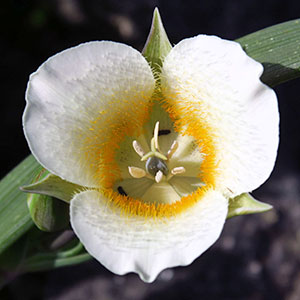Calochortus subalpinus
Calochortus coeruleus
Cascade mariposa lily, cat's ear lily, mountain cat's ear, mountain mariposa, subalpine mariposa-lily
beavertail-grass, blue cat's ear, blue star tulip
usually not branching, straight or flexuous, often scapelike, 0.5–3 dm.
not branching, 0.3–2 dm.
basal 1–3 dm × 2–15 mm, usually equaling or exceeding stem length;
blade flat, adaxial surface glabrous.
basal persistent, 1–2 dm;
blade linear, flat.
subumbellate, 1–5-flowered;
bracts 2–several, lanceolate to linear, unequal, 1–5 cm, apex acuminate;
peduncle slender, becoming stouter, deflexed in fruit.
1–10-flowered.
erect or spreading;
perianth open, campanulate;
sepals typically with purple glandular blotch near base, oblong-lanceolate, shorter than petals, adaxial surface minutely hairy, apex acute to acuminate;
petals yellowish white, sometimes lavender-tinged, frequently with narrow purple crescent distal to gland, broadly obovate, cuneate, moderately bearded nearly to apex, adaxial surface densely hairy, margins fringed, apex obtuse or acute;
glands transversely oblong, arched upward, ± deeply depressed, bordered proximally by narrow, ascending, deeply fringed membrane, distally by narrow, crenate membranes, gland surface with rather long, slender hairs toward distal portion;
anthers lanceolate, apex long-apiculate.
erect to spreading;
perianth open, campanulate;
sepals oblong-lanceolate, ca. 10 mm, glabrous, apex acuminate;
petals light blue, obovate, 8–12 mm, adaxial surface hairy only distal to gland, margins ciliate to apex, apex acuminate;
glands slightly depressed, bordered proximally by ciliate membrane, distally by short hairs;
anthers oblong, apex acute to acuminate.
nodding, 3-winged, ellipsoid, apex usually acute.
nodding, not winged, 1–2 cm, apex acute.
pale yellow.
irregular.
= 20.
= 20.
Calochortus subalpinus
Calochortus coeruleus
Calochortus coeruleus appears to intergrade with C. tolmiei to some extent, especially in petal ciliation (K. L. Chambers, pers. comm.), and it might better be treated as a variety of the latter, more widespread species.
(Discussion copyrighted by Flora of North America; reprinted with permission.)
